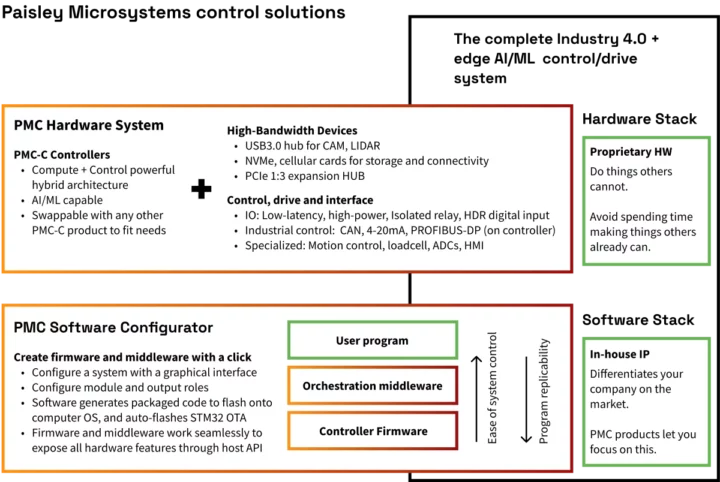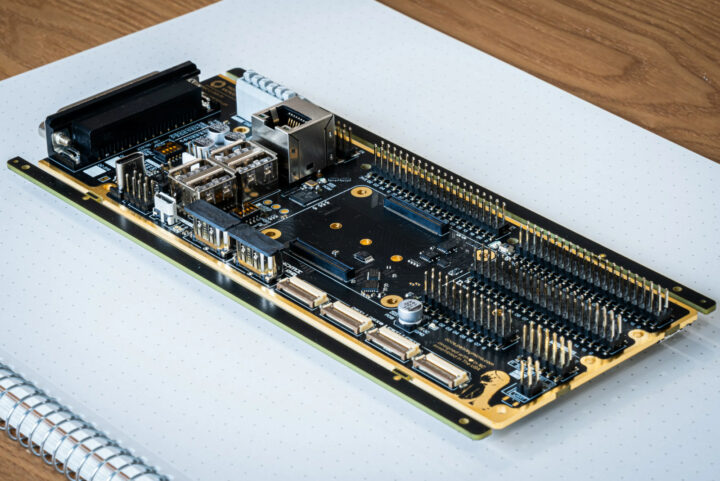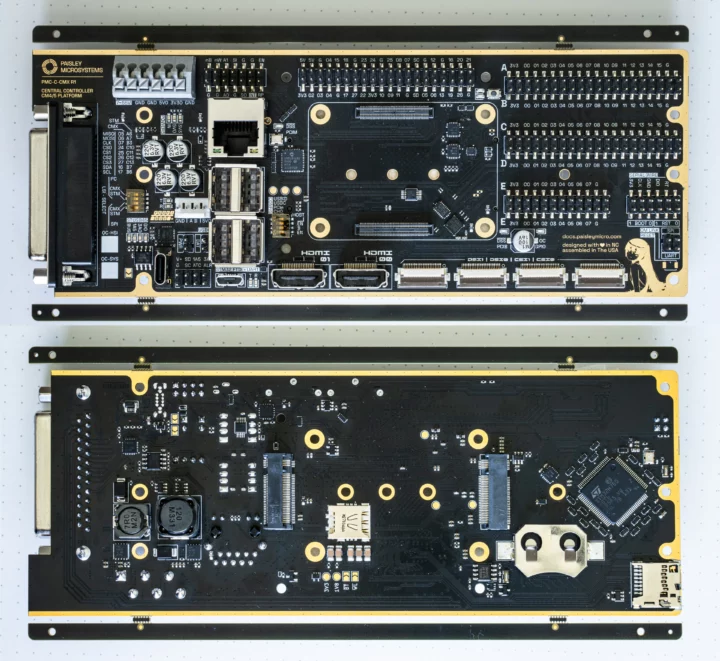Paisley Microsystems PMC-C-CMX is a DIN-Rail mountable industrial control board taking a Raspberry Pi CM4 or CM5 (once launched), equipped with an STM32H7 Arm Cortex-M7 microcontroller for real-time control.
The carrier board integrates features such as wide voltage input (7 to 55V DC), an M.2 PCIe Gen 3 Key-B and Key-M sockets with cellular option, gigabit Ethernet, HDMI and MIPI DSI display interfaces, twp MIPI CSI camera interfaces, and several headers and connectors with RS485, GPIO, I2S, SPI, and more connected to either the Raspberry Pi Compute Module or the STM32H7 MCU.
Paisley Microsystems PMC-C-CMX specifications:
- Supported system-on-modules – Raspberry Pi CM4 or upcoming Raspberry Pi CM5
- MCU – STMicro STM32H7B0 Arm Cortex-M7 microcontroller up to 280 MHz with 128KB flash, 1.4MB SRAM
- MCU <-> CM communication – UART and/or SPI
- Video Output
- 2x HDMI ports up to 4Kp60
- 2x MIPI DSI connectors
- Camera input – 2x MIPI CSI connectors
- Networking
- Gigabit Ethernet RJ45 port
- Optional WiFi 5 and Bluetooth 5
- Optional 4G LTE via M.2 B-key module and Nano SIM card
- USB – 3x or 4x USB 2.0 ports (3x with popular PCIe B card)
- Serial – RS485 up to 20 Mbps with PROFIBUS-DP support
- Expansion
- 40-pin Raspberry Pi-compatible GPIO header
- M.2 M-Key 2280 socket
- M.2 B-Key 2230/3042/2280 socket with Nano SIM card slot (Note: only one M.2 socket can be used at a time due to Broadcom BCM2711/BCM2712 limitations)
- STM32H7 headers with 70 GPIOs
- 25-pin “modular bus connector”
- I2C, SPI, 8x GPIO
- Power signals – 5V/2A, 3.3V/2A, 2x 6A Vin and 4x GND
- Debugging – Dedicated SWD/ST-LINK interface
- Misc – PCF85063AT RTC
- Power Supply
- 7V to 55V DC up to 10A via 6-pin connector
- 9V/12V/20V up to 100W via USB-C PD port
- Quiescent Power Consumption
- Without Compute Module – 560 mW
- With Raspberry Pi CM4 – 2,200 mW
- Dimensions – 190.5 x 72.0 mm; DIN rail compatible
- Temperature Range – -30 to +80°C
The Raspberry Pi CM4/CM runs Linux (Raspberry Pi OS) with logic/control/driving code and a hardware control middleware while the STM32H7 microcontroller runs C or ASM code to control GPIOs in real-time and communicate with the Compute Module over UART or SPI. A simple device control library, the middleware, and STM32H7 firmware will be provided by the company so that customers can focus on the higher-level parts of the software. At this time, I could not find much in the way of publicly available software documentation, but there are more details about the hardware on the documentation website.

Paisley Microsystems sells the PMC-C-CMX industrial control board for Raspberry Pi CM4/CM5 for $149.99 including shipping (at least in the US).

Jean-Luc started CNX Software in 2010 as a part-time endeavor, before quitting his job as a software engineering manager, and starting to write daily news, and reviews full time later in 2011.
Support CNX Software! Donate via cryptocurrencies, become a Patron on Patreon, or purchase goods on Amazon or Aliexpress






